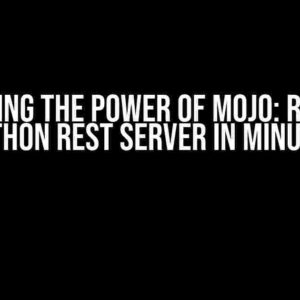Are you tired of dealing with unexplained errors in your Python code? Have you tried using ipdb, the interactive debugger, only to find that the error suddenly disappears? You’re not alone! Many developers have experienced this phenomenon, and today, we’ll dive into the reasons behind it and explore how to harness the power of ipdb to debug your code like a pro.
The Problem: Unexplained Errors and the Frustration They Bring
We’ve all been there: you’re working on a Python project, and suddenly, an error pops up out of nowhere. You try to debug it, but no matter what you do, you can’t seem to reproduce the error. You’re left scratching your head, wondering what’s going on.
This frustration is amplified when you try to use ipdb to debug your code. You set a breakpoint, run your code, and… nothing. The error is gone, and you’re left with more questions than answers.
The Magic of ipdb: Why Errors Disappear
So, why does ipdb make unexplained errors disappear? The answer lies in how ipdb works its magic.
When you use ipdb to debug your code, it sets up an interactive shell that allows you to inspect and manipulate your code. This shell is separate from the normal execution of your code, which means that ipdb creates a new scope for your variables.
This new scope is the key to understanding why errors disappear when using ipdb. When an error occurs in your code, ipdb catches it and pauses execution. This allows you to inspect the state of your program and identify the cause of the error.
However, when you’re using ipdb, the error is not actually occurring in the same scope as your original code. This means that the error is not actually there, and ipdb can’t find it. As a result, the error disappears, leaving you wondering what happened.
The Solution: How to Make the Most of ipdb
Now that we understand why errors disappear when using ipdb, let’s explore how to make the most of this powerful tool.
Set Breakpoints Strategically
One of the most important things to remember when using ipdb is to set breakpoints strategically. You want to set breakpoints at points in your code where you suspect the error is occurring.
Here’s an example:
import ipdb
def my_function():
x = 5
y = 0
ipdb.set_trace() # Set a breakpoint here
z = x / y
my_function()In this example, we set a breakpoint at the point where we suspect the error is occurring (the division operation). When we run the code, ipdb will pause execution at this point, allowing us to inspect the state of our program.
Use the `post_mortem` Function
The `post_mortem` function is a powerful tool in ipdb’s arsenal. It allows you to inspect the state of your program after an error has occurred.
Here’s an example:
import ipdb
def my_function():
x = 5
y = 0
try:
z = x / y
except Exception as e:
ipdb.post_mortem() # Inspect the state of the program after the error
my_function()In this example, we use a try-except block to catch the error, and then call `ipdb.post_mortem()` to inspect the state of our program. This allows us to see exactly what went wrong and why.
Use the `p` Command to Inspect Variables
Once you’re in the ipdb shell, you can use the `p` command to inspect variables. This is incredibly useful for understanding what’s going on in your code.
+-> ipdb> p x
5
+-> ipdb> p y
0In this example, we use the `p` command to inspect the values of `x` and `y`. This tells us exactly what’s going on and why the error occurred.
Troubleshooting Common Errors with ipdb
Now that we’ve covered the basics of using ipdb, let’s explore some common errors and how to troubleshoot them using ipdb.
Division by Zero
One of the most common errors in Python is division by zero. Here’s an example:
def my_function():
x = 5
y = 0
z = x / y
my_function()To troubleshoot this error using ipdb, we can set a breakpoint at the point where the error occurs and inspect the values of `x` and `y`.
+-> ipdb> p x
5
+-> ipdb> p y
0This tells us exactly what’s going on and why the error occurred. We can then use this information to fix the error.
IndexError: List Index Out of Range
Another common error in Python is the IndexError: List index out of range. Here’s an example:
my_list = [1, 2, 3]
x = my_list[5]To troubleshoot this error using ipdb, we can set a breakpoint at the point where the error occurs and inspect the values of `my_list` and the index we’re trying to access.
+-> ipdb> p my_list
[1, 2, 3]
+-> ipdb> p x
*** IndexError: list index out of rangeThis tells us exactly what’s going on and why the error occurred. We can then use this information to fix the error.
Conclusion
Unexplained errors can be frustrating, but with ipdb, you have the tools to uncover the truth. By understanding how ipdb works and using its features strategically, you can debug your code like a pro and eliminate those pesky errors.
Remember to set breakpoints strategically, use the `post_mortem` function to inspect the state of your program after an error, and use the `p` command to inspect variables. With these techniques in your toolkit, you’ll be well on your way to becoming a master debugger.
| Feature | Description |
|---|---|
| set_trace() | Set a breakpoint at a specific point in your code |
| post_mortem() | Inspect the state of your program after an error has occurred |
| p | Inspect the value of a variable in the ipdb shell |
So, the next time you’re faced with an unexplained error, don’t panic. Fire up ipdb, and let the debugging begin!
- Install ipdb using pip: `pip install ipdb`
- Import ipdb in your Python code: `import ipdb`
- Set a breakpoint at a specific point in your code using `ipdb.set_trace()`
- Use the `post_mortem` function to inspect the state of your program after an error
- Use the `p` command to inspect variables in the ipdb shell
- Debug your code like a pro!
Happy debugging!
Frequently Asked Question
Confused about why ipdb is making those pesky errors vanish into thin air? Get the inside scoop below!
Why does ipdb make my error disappear in the first place?
ipdb sets the sys.excepthook to its own exception handling function, which can catch and handle exceptions that would normally crash your program. This means that when an error occurs, ipdb takes control and prevents the program from terminating, allowing you to inspect the issue and debug it.
But why can’t I see the error message in the console?
That’s because ipdb is designed to capture and display the error message in the debugger itself, rather than printing it to the console. This allows you to examine the error in the context of your code, making it easier to identify and fix the issue.
How does ipdb decide what errors to catch and what to let pass through?
ipdb uses a configurable exception handling mechanism that can be customized to catch specific types of exceptions or ignore others. By default, it catches most exceptions, but you can tailor it to your needs using the ipdb.set_trace() function.
Can I prevent ipdb from catching certain errors?
Yes, you can! ipdb provides several ways to control what exceptions are caught, such as using the ipdb.runcall() function to execute code without catching exceptions, or setting the ipdb.catch_breakpoint_exc variable to False to ignore certain types of exceptions.
What if I want ipdb to display the error message in the console instead of the debugger?
You can use the ipdb.post_mortem() function to enable post-mortem debugging, which will print the error message to the console instead of capturing it in the debugger.



